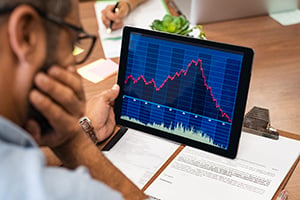 Yesterday, we talked about why it might be 1998—or 1999—all over again. After all, many of the conditions are similar. Although growth continues for now and we may get a lifeline, you might be concerned that the economy could be settling into a recession in the next couple of quarters. Our most recent experience of a recession and market decline, 2008–2009, has left horrific memories. So, should we be panicking? In a word, no.
Yesterday, we talked about why it might be 1998—or 1999—all over again. After all, many of the conditions are similar. Although growth continues for now and we may get a lifeline, you might be concerned that the economy could be settling into a recession in the next couple of quarters. Our most recent experience of a recession and market decline, 2008–2009, has left horrific memories. So, should we be panicking? In a word, no.
In the year 2000
In 2008, we experienced a real crisis for both the economy and markets. In the year 2000, on the other hand, we saw a rather mild recession, not a systemic crisis like 2008. The market declines in 2000 were significant but, again, not as bad as those of 2008. They largely reflected the high valuations of the technology sector, rather than a general collapse of corporate profits. In other words, if we get another 2000, it likely won’t be another 2008. But if we shouldn’t be panicking, what should we be doing?
Ride it out
For many people—including younger individuals who are still accumulating wealth rather than spending it in retirement—the answer is very likely to keep doing what you’re doing. Save and invest. The great thing about market downturns is that you can buy cheap, which helps returns over time. At the same time, the loss of value of your existing investments doesn’t matter, as you won’t be spending them for some time. So, for people who are still saving, sitting tight makes a lot of sense.
Similarly, for those who have enough saved to live off the interest and dividends, or who have enough cash and low-risk investments to ride out a bear market, there is likely no need to do anything different. Bear markets pass. Unless you need the money to spend, it often makes sense to simply ride it out.
Take defensive action
There are, however, two groups of people who might want to take defensive action: those who simply can’t afford financially to see their savings decline and those who can’t afford to do so mentally. In both cases, you must do something. But what?
One simple answer is to switch some at-risk investments (e.g., stocks) to lower-risk areas. You can then draw on the lower-risk investments to spend, if necessary, and give the stocks time to recover. Another, more extreme form of this strategy is to take some of your investment portfolio to cash. Again, you will get spending power, as well as the ability to reinvest when conditions are more favorable. In fact, I wrote a book (Crash-Test Investing) about how to do just that. Although this approach has its downsides, it can reduce the risks—both financial and mental—of a market pullback.
The time is now
In any case, here is the main takeaway from 1998: you can do something, if you want or need to, but you certainly don’t have to. Both approaches work well over time, and both have merit. The course you choose depends on your own situation.
With economic conditions at yellow light status and with the market weakening, you don’t want to delay making that decision. Decisions made ahead of time, without stress, tend to be better than those made in the midst of turmoil. You may not need to do anything, but the time to decide that—on your own or in conjunction with your financial advisor—is now.
So, the real lesson of 1998 (or any time really) is to plan ahead. Now is a good time to do just that.


 Print
Print

